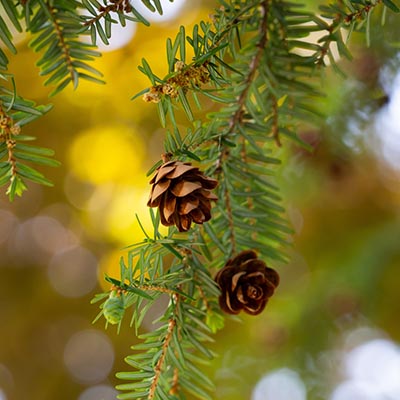 When the glaciers moved in across Indiana, they brought with them a few hitchhikers - the seeds of eastern hemlocks, which resemble small pinecones. As the enormous ice sheets melted, the seeds dropped out and were planted in the soil below. A boreal forest, dominated by spruce and hemlocks, was formed in present-day Indiana. As the glaciers continued to recede, the climate began to warm. Oaks, hickories, maples, and other deciduous (leaf dropping) trees began to shade out the hemlock seedlings, thus changing the composition of much of Indiana’s forests.
When the glaciers moved in across Indiana, they brought with them a few hitchhikers - the seeds of eastern hemlocks, which resemble small pinecones. As the enormous ice sheets melted, the seeds dropped out and were planted in the soil below. A boreal forest, dominated by spruce and hemlocks, was formed in present-day Indiana. As the glaciers continued to recede, the climate began to warm. Oaks, hickories, maples, and other deciduous (leaf dropping) trees began to shade out the hemlock seedlings, thus changing the composition of much of Indiana’s forests.
A few remnant eastern hemlock stands do remain in Indiana. Turkey Run and Shades State Parks have sandstone canyons that create a cooler climate in which eastern hemlocks thrive. Because they do not depend on a long taproot, the hemlocks are able to grow literally out of sandstone without much soil. The other species of trees that out-competed the ancestors of current hemlocks are unable to grow in such harsh conditions. The hemlocks grow very slowly due to the lack of fertile soil. An eastern hemlock seedling may be 50 years old and only 6 feet tall! The winter is the best time to pick out eastern hemlock because it does not drop its leaves like our commonly found deciduous trees do.
So the next time you walk through the cool, moist canyons at Turkey Run or Shades State Parks take a glance above you to notice the needle-leafed monuments to a time long past.
